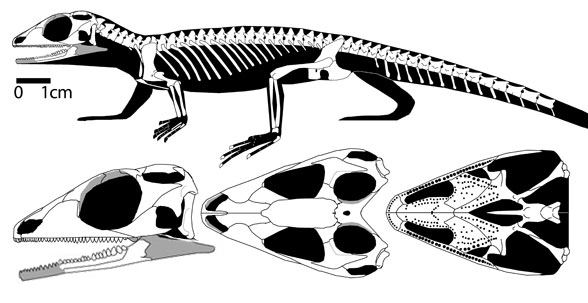Kingdom Animalia Family †Gephyrosauridae Phylum Chordata Order Rhynchocephalia | Class Reptilia Species †G. bridensis Rank Genus | |
 | ||
Similar Rhynchocephalia, Planocephalosaurus, Palaeopleurosaurus, Clevosaurus, Diphydontosaurus | ||
Gephyrosaurus is a genus of early Rhynchocephalia first described and named in 1980 by Susan E. Evans. They are distantly related to the extant Sphenodon (tuatara of New Zealand) with which they shared a number of skeletal features including a large tooth row along the side of the palatine bone (part of the palate) and posterior process of the dentary bone (part of the lower jaw). They lived during Early Jurassic in Wales, UK. The primitive cranial features of this organism places it within the order of Eosuchia.
Contents
Limbs
Observation of the skeletal elements of Gephyrosaurus bridensis makes it evident that this was very much a lizard-like creature. It possessed relatively long, slender legs which would allow it to run quickly in pursuit of prey or in escape from larger predators. While many small lizards are able to climb trees, it is possible this organism was not fully arboreal although it possessed strong legs and claws which would make it possible to climb. It is unlikely Gephyrosaurus was bipedal.
Vertebrae
Two distinct vertebrae from Gephyrosaurus bridensis were described, and these vertebrae are very similar to the modern Rhychocephalian Sphenodon, providing strong evidence that the two genera are related
Dentition
Gephyrosaurus bridensis possessed pleurodont dentition that is believed to have replaced slowly during the animal's lifetime. In her 1985 paper, Evans suggests that this could be the ancestral state for tooth replacement in lepidosaurs.
Behavior
Gephyrosaurus was a terrestrial reptile and is assumed to be an insectivore that used a patient feeding strategy as it waited for prey to arrive. High incidence of jaw fractures found among specimens infers that this animal was potentially territorial and would attack those who crossed into their home range.
